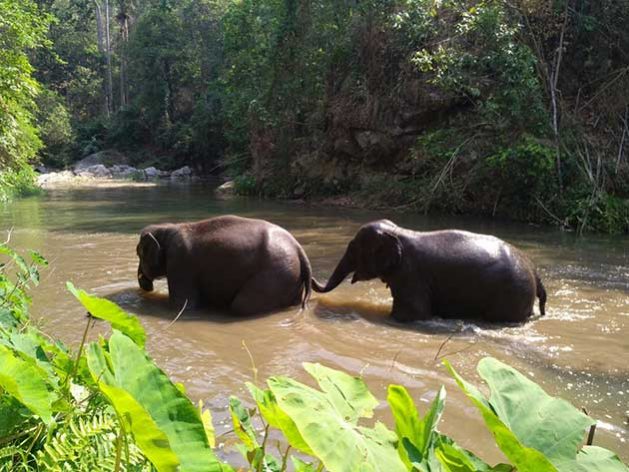Wildlife Is Much More than a Safari. And It Is at Highest Risk of Extinction

MADRID, Mar 01 (IPS) - Wildlife is indeed far much more than a safari or an ‘exotic’ ornament: as many as four billion people –or an entire half the whole world's population– rely on wild species for income, food, medicines and wood fuel for cooking.
In spite of that, one million species of plants and animals are already facing extinction due to the voracious profit-making, over-exploitative, illegal trade and the relentless depletion of the variety of life on Planet Earth.
In fact, billions of people, both in developed and developing nations, benefit daily from the use of wild species for food, energy, materials, medicine, recreation, and many other vital contributions to human well-being, as duly reports the UN on the occasion of the 2023 World Wildlife Day (3 March).
Much so that 50,000 wild species meet the needs of billions worldwide. And 1 in 5 people around the world rely on wild species for income and food, while 2.4 billion people depend on wood fuel for cooking.
The world's major multilateral body reminds us of the “urgent need to step up the fight against wildlife crime and human-induced reduction of species, which have wide-ranging economic, environmental and social impacts.”
Variety of life, lost at an “alarming rate”
A world organisation leading in wildlife conservation and protection of endangered species: the World Wildlife Fund (WWF) warns that unfortunately, we’re losing biodiversity — the rich variety of life on Earth — at an “alarming rate.”
“We’ve seen a 69% average decline in the number of birds, amphibians, mammals, fish, and reptiles since 1970, according to the 2022 Living Planet Report.
“A million plant and animal species are threatened with extinction, we have lost half of the world’s corals and lose forest areas the size of 27 football fields every minute.”
WWF highlights the following findings, among several others:
- 69% average decline in wildlife populations since 1970,
- Wildlife populations in Latin America and the Caribbean plummeting at a staggering rate of 94%,
- Freshwater species populations have suffered an 83% fall.
Major causes
The 2022 Living Planet Report points out some of the major causes leading to the shocking loss of the world's biodiversity.
“The biggest driver of biodiversity loss is the way in which people use the land and sea. How we grow food, harvest materials such as wood or minerals from the ocean floor, and build our towns and cities all have an impact on the natural environment and the biodiversity that lives there.”
Food systems: the biggest cause of Nature loss: according to findings provided by WWF, food production has caused 70% of biodiversity loss on land and 50% in freshwater. It is also responsible for around 30% of all greenhouse gas emissions.
As a global population, what we’re eating and how we’re producing it right now is good for neither us nor the planet. While over 800 million people are going hungry, over two billion of those who do have enough food are obese or overweight.
The WWF provided findings also indicate that meat tends to have the highest environmental impact, partially because livestock produce methane emissions through their digestive process - something called enteric fermentation - but also because most meat comes from livestock fed with crops.
And that around 850 million people around the world are thought to rely on coral reefs for their food and livelihoods.
WWF’s report also refers to the invasive non-native species: Invasive non-native species are those that arrive in places where they historically didn’t live and out-compete local biodiversity for resources such as sunlight and water. This causes the native species to die out, causing a shift in the makeup of the natural ecosystem.
Future depends on reversing the loss of Nature
“The world is waking up to the fact that our future depends on reversing the loss of nature just as much as it depends on addressing climate change. And you can’t solve one without solving the other,” said Carter Roberts, president and CEO of WWF-US.
“These plunges in wildlife populations can have dire consequences for our health and economies,” says Rebecca Shaw, global chief scientist of WWF.
“When wildlife populations decline to this degree, it means dramatic changes are impacting their habitats and the food and water they rely on. We should care deeply about the unravelling of natural systems because these same resources sustain human life.”
In view of all the above, the causes of the fast destruction of the variety of life have been scientifically identified as well as the dangerous consequences. However, the dominant private business continues to see more profits in destroying than in saving.
© Inter Press Service (2023) — All Rights Reserved. Original source: Inter Press Service
Where next?
Browse related news topics:
Read the latest news stories:
- Forest Guards Risking Their Lives To Keep Malawi’s Forests Standing Monday, March 31, 2025
- Global Climate Action Progressing, but Speed and Scale Still Lacking Monday, March 31, 2025
- ‘Student Protests Have Sparked Solidarity, Empathy and a Renewed Belief in Collective Action’ Monday, March 31, 2025
- Southeast Asia’s Economies Can Gain Most by Packaging Ambitious Reforms Monday, March 31, 2025
- Myanmar earthquake: Search and rescue efforts continue in race against time Sunday, March 30, 2025
- Looking beyond GDP to reach the Sustainable Development Goals Saturday, March 29, 2025
- UN chief strongly condemns killing of Kenyan peacekeeper in Central African Republic Saturday, March 29, 2025
- Myanmar quake: More than 1,600 reported killed, as UN aid operation supports rescue efforts Saturday, March 29, 2025
- Water and Food Security in Europe and Central Asia: A Shared Challenge for a Sustainable and Just Future Friday, March 28, 2025
- Latin America & the Caribbean in 2024: Renewable Energy and Early Warning Systems Offer Hope Amid Climate Extremes Friday, March 28, 2025